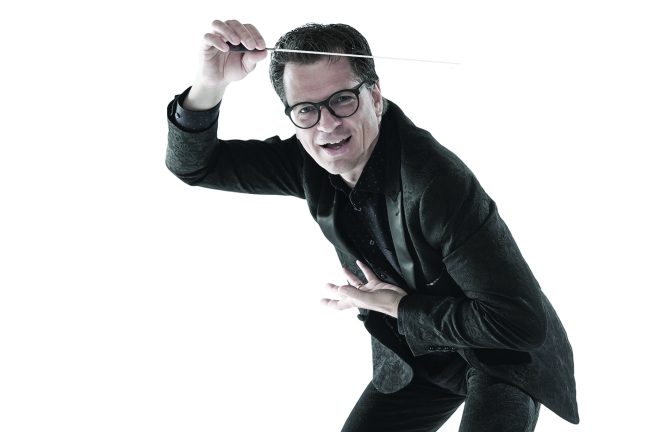 Music Director and Conductor
Music Director and Conductor
Martin Majkut is an internationally recognized conductor acclaimed for his dynamic leadership and adventurous programming. He currently serves as Music Director of the Rogue Valley Symphony (OR) and the Oregon Coast Music Festival. From 2016 to 2025, he was Music Director of the Queens Symphony Orchestra in New York.
A native of Bratislava, Slovakia, Majkut holds doctorates in conducting from the Academy of Performing Arts (Slovakia) and the University of Arizona. He is a Fulbright Scholar and has studied in Siena and Vienna. During the pandemic, he created films and a video series offering insights into a conductor’s process. He continues to appear regularly as a guest conductor in the U.S. and Europe. Learn more at www.martinmajkut.com.
Program Notes Orchestra I: The Melting Pot
One of the first two women ever commissioned to compose an opera for the Met, Missy Mazzoli has made her original voice heard—and lauded—across the country. In Sinfonia (for Orbiting Spheres), she delights in turning the orchestra into a “makeshift hurdy-gurdy, flung recklessly into space.”
Mazzoli adds a touch of whimsy to her orchestration: eight of our players (bassoons and brass) alternate their primary instruments with harmonicas. The effect is brilliant—the harmonicas make the orchestra feel weightless. Hold on to your seats, just in case!
One of my all-time favorite pieces—Dvořák’s Cello Concerto—offers a view of our land through the eyes of an outsider. It was written during the composer’s stay in America. The music is an amalgam: the sounds of a new and exciting country blend with the yearning of a homesick composer.
To me, this concerto is a symphony with one leading voice. The cello becomes our narrator and guide. It speaks of a life well lived, full of both glory and sorrow. It’s a stroke of fortune that the South Coast has recently gained a bona fide virtuoso. Dace Gregory can make this music sing and cry in all the right places.
In perfect melting-pot tradition, Bernstein took the quintessentially American form—a musical—infused it with jazz (another American invention) and topped it off with two imported ingredients: Latin rhythms and a European symphonic sensibility. West Side Story was a groundbreaking achievement. Many of its numbers entered the popular canon, in no small part due to the Symphonic Dances. This nine-movement orchestral suite turbocharges some of the best tunes from the musical using an impressive array of orchestral forces. The result is a virtuosic, exhilarating, and unmistakably American score.
Program Notes Orchestra II: Four Love Scenes
Love turns us into aspiring poets and balladeers. Here are four musical stories to capture your imagination!
Beatrice and Benedict from Shakespeare’s Much Ado About Nothing get on each other’s nerves—constantly! Yet, inexplicably to them, they’re drawn together. One might say they fall in love despite their best efforts. Berlioz captures their quarreling chemistry brilliantly: the music hops and skips around as if every instrument wants to have the last word.
The Butterfly Lovers is best described as a Chinese Romeo and Juliet. The violin concerto of the same name was composed in 1959 by a “collective” of two composers—a rare instance where writing by committee produced something truly special. The work was suppressed during the Cultural Revolution, but today it’s considered the most popular classical piece in China. Its melodies can often be heard played by street musicians.
The concerto not only narrates the key scenes of the story but also tells a larger tale—of Western classical music’s absorption into Chinese culture. The result is a lyrical work that sounds both familiar and alluringly different. Nancy Zhou brings out these contrasts with singular passion. I’m thrilled to welcome her to the Festival!
It’s said that after the early performances of Wagner’s Tristan und Isolde, audience members were so emotionally overwhelmed they cried themselves to sleep. Fortunately, we’re only performing an excerpt tonight, so your rest should remain undisturbed. But what a hypnotic work this is: it begins with the opera’s revolutionary Prelude—where, for the first time in history, music never resolves to a home key—and ends with the climactic scene of Isolde’s death over Tristan’s lifeless body. Don’t resist its pull. Let yourself be transported into a world where love is so intense, it transcends life itself.
Finally, Stravinsky’s Romantic masterpiece: The Firebird. Prince Ivan battles the evil Koschei with help from the magical Firebird, all in pursuit of a young princess’s hand. This score is a masterclass in brilliant orchestration, filled with themes as enduring as immortal Koschei himself. It culminates in a triumphant celebration that will stay with you long after the final orchestral crescendo.